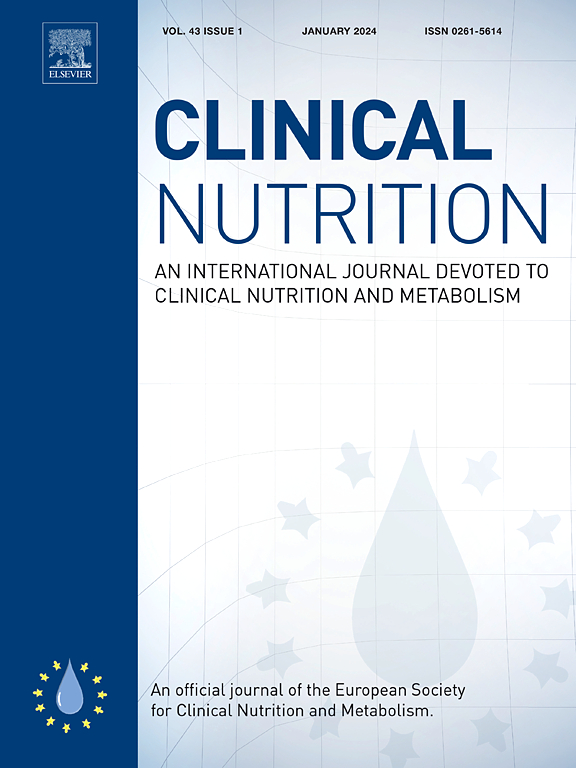Low serum glycine strengthens the association between branched-chain amino acids and impaired insulin sensitivity assessed before and after weight loss in a population with pre-diabetes: The PREVIEW_NZ cohort
IF 7.4
2区 医学
Q1 NUTRITION & DIETETICS
引用次数: 0
Abstract
Aim
Accumulation of circulating branched-chain amino acids (BCAA) is a hallmark feature of impaired insulin sensitivity. As intracellular BCAA catabolism is dependent on glycine availability, we hypothesised that the concurrent measurement of circulating glycine and BCAA may yield a stronger association with markers of insulin sensitivity than either BCAA or glycine alone. This study therefore examined the correlative relationships of BCAA, BCAA and glycine together, plus glycine alone on insulin sensitivity-related markers before and after an 8-week low energy diet (LED) intervention.
Methods
This is a secondary analysis of the PREVIEW (PREVention of diabetes through lifestyle Intervention and population studies in Europe and around the World) Study New Zealand sub-cohort. Eligible participants with pre-diabetes at baseline who achieved ≥8 % body weight loss following an LED intervention were included, of which 167 paired (Week 0 and Week 8) blood samples were available for amino acid analysis. Glycemic and other data were retrieved from the PREVIEW consortium database. Repeated measures linear mixed models were used to test the association between amino acids and insulin sensitivity-related markers (HOMA2-IR, glucose, insulin, and C-peptide).
Results
Elevated BCAA was associated with impaired insulin sensitivity (p < 0.05), with strength of association (ηp2) almost doubled when glycine was added to the model. However, glycine in isolation was not associated with insulin sensitivity-related markers. The magnitude (β-estimates) of positive association between BCAA and HOMA2-IR, and inverse association between glycine and HOMA2-IR, increased when body weight was higher (Body weight∗BCAA, Body weight∗glycine, p < 0.05, both).
Conclusion
Low serum glycine strengthened the association between BCAA and impaired insulin sensitivity. Given that glycine is necessary to facilitate intracellular BCAA catabolism, measurement of glycine is necessary to complement BCAA analysis to comprehensively understand the contribution of amino acid metabolism in insulin sensitivity.
Clinical trial registration
This study was registered with ClinicalTrials.gov (NCT01777893).
在糖尿病前期人群中,低血清甘氨酸加强了支链氨基酸与减肥前后胰岛素敏感性受损之间的联系:PREVIEW_NZ 队列
目的循环支链氨基酸(BCAA)的积累是胰岛素敏感性受损的一个标志性特征。由于细胞内 BCAA 的分解代谢依赖于甘氨酸的供应,我们假设同时测量循环中的甘氨酸和 BCAA 可能比单独测量 BCAA 或甘氨酸与胰岛素敏感性指标有更强的关联。因此,本研究考察了在为期 8 周的低能量饮食(LED)干预前后,BCAA、BCAA 和甘氨酸共同与单独甘氨酸对胰岛素敏感性相关指标的相关关系。方法这是 PREVIEW(在欧洲和世界各地通过生活方式干预和人口研究预防糖尿病)研究新西兰子队列的二次分析。研究纳入了基线值为糖尿病前期、在接受 LED 干预后体重减轻≥8% 的合格参与者,其中 167 份配对(第 0 周和第 8 周)血液样本可用于氨基酸分析。血糖和其他数据均来自 PREVIEW 联合数据库。采用重复测量线性混合模型检验氨基酸与胰岛素敏感性相关指标(HOMA2-IR、葡萄糖、胰岛素和 C 肽)之间的关联。结果BCAA升高与胰岛素敏感性受损有关(p <0.05),当甘氨酸加入模型时,关联强度(ηp2)几乎翻倍。然而,单独的甘氨酸与胰岛素敏感性相关指标无关。当体重较高时,BCAA 与 HOMA2-IR 之间正相关的程度(β-估计值)以及甘氨酸与 HOMA2-IR 之间反相关的程度(体重∗BCAA,体重∗甘氨酸,两者均为 p < 0.05)均有所增加。鉴于甘氨酸是促进细胞内 BCAA 分解代谢所必需的物质,因此有必要测量甘氨酸以补充 BCAA 分析,从而全面了解氨基酸代谢对胰岛素敏感性的影响。临床试验注册本研究已在 ClinicalTrials.gov (NCT01777893) 上注册。
本文章由计算机程序翻译,如有差异,请以英文原文为准。
求助全文
约1分钟内获得全文
求助全文
来源期刊

Clinical nutrition
医学-营养学
CiteScore
14.10
自引率
6.30%
发文量
356
审稿时长
28 days
期刊介绍:
Clinical Nutrition, the official journal of ESPEN, The European Society for Clinical Nutrition and Metabolism, is an international journal providing essential scientific information on nutritional and metabolic care and the relationship between nutrition and disease both in the setting of basic science and clinical practice. Published bi-monthly, each issue combines original articles and reviews providing an invaluable reference for any specialist concerned with these fields.
 求助内容:
求助内容: 应助结果提醒方式:
应助结果提醒方式:


